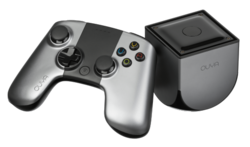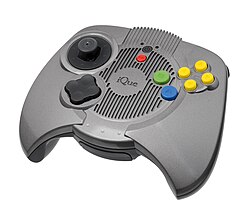Microconsole
This article needs to be updated. (September 2018) |

A microconsole is a
Origins

The iQue Player was released in 2003 as a low-cost handheld TV game console based on the Nintendo 64, specifically designed for the Chinese market. At launch, games were available for download from iQue Depot kiosks. In October 2004, the iQue@Home application store was introduced, allowing users to download games from home,[1] potentially making it the first microconsole of its kind.
In the early 2010s, shortly after the rise of
In late 2010, cloud gaming startup OnLive released MicroConsole, a television adapter and wireless gamepad that connects the company's video game streaming service to televisions.[5] VentureBeat's Dean Takahashi described the device as representing the company founder's "vision to turn the video game industry upside down" as an inexpensive console providing "high-end games on low-end hardware" that could eliminate the cycle of regular consumer hardware upgrades.[6][7] The MicroConsole TV adapter was produced at a loss.[7] OnLive's MicroConsole made the company an early leader in the nascent microconsole field.[8]
Amidst a "new war for TV" in the
The PlayStation TV (known in Asia as the PlayStation Vita TV) is a microconsole announced in September 2013 at a Sony Computer Entertainment Japan presentation.[26][27][28] It was released in Japan on November 14, 2013 and in North America on October 14, 2014.
Home-made Devices
Reception
The pre-release Ouya was panned by early reviewers.[35] The Verge called it unfinished,[36] and in a later review, Eurogamer questioned why consumers would purchase a console that duplicated the functionality of smartphones they already had.[10]
The video game industry saw
See also
References
- ^ "IQue Software and iQue@Home". IGN. 30 August 2014. Retrieved 30 September 2024.
- ^ Gaudiosi, John (October 16, 2014). "How Android TV is a (video) game changer". Fortune. Retrieved June 21, 2021.
- Gamasutra. Retrieved June 21, 2021.
- ^ a b Kelly, Tadhg (March 14, 2013). "Why 2013 could be the year of the microconsole". Edge. Future Publishing. Archived from the original on May 31, 2013. Retrieved June 8, 2013.
- CBS Interactive. Archivedfrom the original on March 13, 2016. Retrieved June 7, 2013.
- ^ Takahashi, Dean (November 17, 2010). "OnLive starts pre-sales for MicroConsole aimed at eliminating game consoles". VentureBeat. Archived from the original on October 24, 2012. Retrieved June 7, 2013.
- ^ a b Hollister, Sean (August 28, 2012). "OnLive lost: how the paradise of streaming games was undone by one man's ego". The Verge. Vox Media. Archived from the original on June 15, 2013. Retrieved June 7, 2013.
- ^ a b c Griffiths, Daniel Nye (May 9, 2013). "OUYA Closes $15 Million Round, Sets Up Microconsole Showdown". Forbes. Archived from the original on June 10, 2013. Retrieved June 7, 2013.
- ^ Patel, Nilay (November 12, 2012). "Over the top: the new war for TV is just beginning". The Verge. Vox Media. Archived from the original on May 21, 2013. Retrieved June 8, 2013.
- ^ a b McFerran, Damien (June 8, 2013). "Ouya review". Eurogamer. Gamer Network. Archived from the original on June 10, 2013. Retrieved June 8, 2013.
- ^ Plunkett, Luke (August 9, 2012). "Ouya's Ridiculously Successful Kickstarter Ends With Millions in the Bank". Kotaku. Gawker Media. Archived from the original on May 15, 2013. Retrieved June 7, 2013.
- AOL Tech. Archivedfrom the original on June 8, 2013. Retrieved June 7, 2013.
- ^ a b Hollister, Sean (January 10, 2013). "Nvidia's Project Shield: right on time". The Verge. Vox Media. Archived from the original on April 30, 2013. Retrieved June 7, 2013.
- ^ a b Thier, David (May 9, 2013). "There's A New, Free Console Competing With The Ouya". Forbes. Archived from the original on June 8, 2013. Retrieved June 8, 2013.
- ^ McElroy, Griffin (November 6, 2012). "Guitar Hero co-creator developing virtual gaming console for smartphones and TVs". Polygon. Vox Media. Archived from the original on November 11, 2012. Retrieved June 8, 2013.
- ^ Grubb, Jeffrey (May 30, 2013). "The console alternatives: Everything you need to know about Ouya, GameStick, and Shield". VentureBeat. Archived from the original on June 9, 2013. Retrieved June 8, 2013.
- ^ a b Grant, Christopher (January 15, 2013). "Android 'consoles' and Steam Boxes dominate gaming at CES, while consoles sit it out". Polygon. Vox Media. Archived from the original on June 5, 2013. Retrieved June 7, 2013.
- ^ UBM TechWeb. Archivedfrom the original on May 29, 2013. Retrieved June 8, 2013.
- AOL Tech. Archivedfrom the original on June 20, 2013. Retrieved June 7, 2013.
- Viacom. Archived from the originalon January 24, 2013. Retrieved June 7, 2013.
- ^ Corriea, Alexa Ray (February 1, 2013). "GameStick ends Kickstarter campaign with just under $650K, meets all stretch goals". Polygon. Vox Media. Archived from the original on May 12, 2013. Retrieved June 7, 2013.
- ^ Pitcher, Jenna (June 2, 2013). "GamePop Android microconsole launching in winter for $129, free with subscription". Polygon. Vox Media. Archived from the original on June 9, 2013. Retrieved June 7, 2013.
- ^ Sarkar, Samit (June 7, 2013). "Mad Catz working on Project M.O.J.O. Android micro-console, showing it at E3". Polygon. Vox Media. Archived from the original on June 10, 2013. Retrieved June 7, 2013.
- GamesIndustry. Gamer Network. Archivedfrom the original on June 7, 2013. Retrieved June 7, 2013.
- ^ Trew, James (June 7, 2013). "Mad Catz CEO announces 'Project M.O.J.O.' Android gaming console coming at E3". Engadget. AOL Tech. Archived from the original on June 10, 2013. Retrieved June 7, 2013.
- ^ "Sony Announces $100 'PlayStation Vita TV' Micro-Console". Forbes. Retrieved 2013-10-02.
- ^ Gilbert, Ben (2013-09-18). "Hands-on with the PlayStation Vita TV, Sony's $100 microconsole (update: video!)". Engadget.com. Retrieved 2013-10-02.
- ^ "News: Sony announces PS Vita TV microconsole". ComputerAndVideoGames.com. 2013-09-09. Retrieved 2013-10-02.
- ^ Bixenspan, David (2024-06-22). "Is RetroPie Available For Raspberry Pi 5? Here's What You Need To Know". SlashGear. Retrieved 2025-01-09.
- ^ Adamson, Bon (2024-09-06). "I tried both RetroArch and RetroPie to find out which emulator is actually better". Pocket-lint. Retrieved 2025-01-09.
- UBM TechWeb. Retrieved June 8, 2013.
- GamesIndustry. Gamer Network. Archivedfrom the original on June 8, 2013. Retrieved June 8, 2013.
- ^ AOL Tech. Archivedfrom the original on May 29, 2013. Retrieved June 8, 2013.
- ^ Maxwell, Ben (January 2, 2013). "GameStick Android console competes with Ouya and eSfere for public money". Edge. Future Publishing. Retrieved June 8, 2013.
- ^ Kain, Erik (April 7, 2013). "Early Ouya Reviews Trickle In And They're Not Pretty". Forbes. Archived from the original on May 29, 2013. Retrieved June 8, 2013.
- ^ Pierce, David (April 4, 2013). "Ouya review: can an indie console take on Sony and Microsoft?". Polygon. Vox Media. Archived from the original on June 1, 2013. Retrieved June 8, 2013.
- Yahoo! Games. Archivedfrom the original on May 18, 2013. Retrieved June 7, 2013.
- ^ Fahey, Mike (June 7, 2013). "Monday Is The Perfect Day For Apple To Reveal A Game Controller". Kotaku. Gawker Media. Archived from the original on June 10, 2013. Retrieved June 7, 2013.
